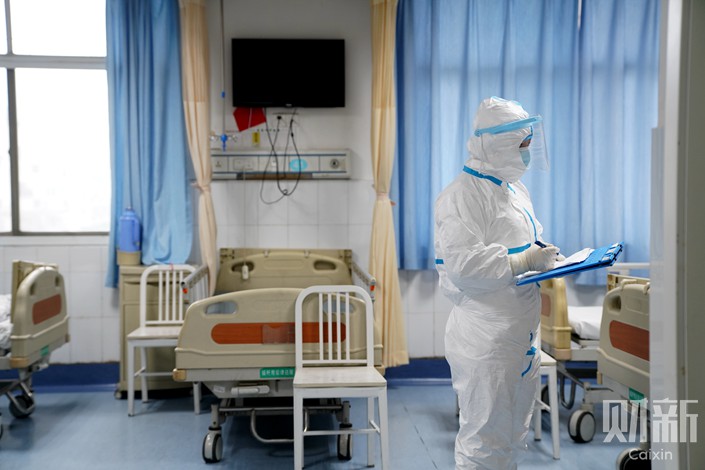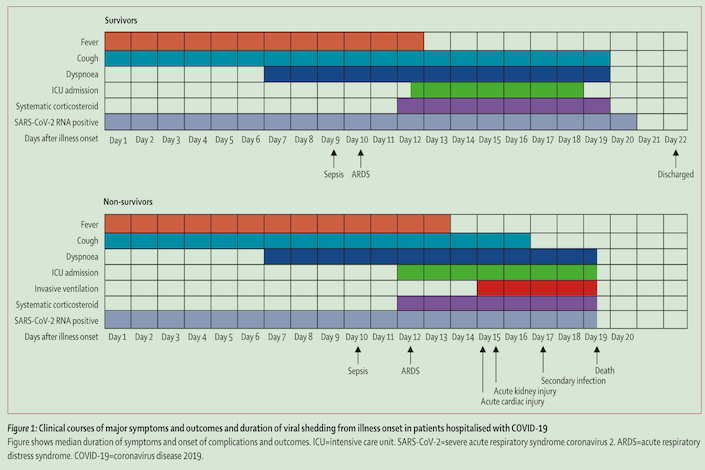Covid-19 Patients Shed Virus Far Longer Than Thought, Researchers Report

 |
A newly published paper identifies the risk factors and clinical course of patients who died from Covid-19 and suggests for the first time that patients shed the virus far longer than expected.
The paper, produced by a team led by China-Japan Friendship Hospital Vice President Cao Bin and published Monday by the prestigious medical journal The Lancet, is the first research focusing on fatal cases of coronavirus disease. It may provide important clinical guidelines to help doctors anticipate mild patients turning into severe cases, Cao said.
Cao was part of the first expert panel dispatched by the National Health Commission to Wuhan Dec. 31 to investigate the outbreak. He is also in charge of clinical trials using Gilead Sciences’ remdesivir to treat Covid-19 patients in China.
The study of 191 patients, of whom 54 died before Jan. 31, found increasing probability of death associated with older age, higher organ failure and higher d-dimer, an indicator that may signal a significant blood clot.
The paper also found that the median duration of viral shedding was 20 days in survivors, but the virus was detectable until death in nonsurvivors. The longest observed duration of viral shedding in survivors was 37 days, and the shortest was eight days.
Viral shedding refers to the expulsion and release of virus progeny following successful reproduction during a host-cell infection. Once replication has been completed and the host cell is exhausted of all resources in making viral progeny, the viruses may begin to leave the host.
The level and duration of virus replication are important factors in assessing transmission risk and guide decision-making in treatment and quarantine, the paper says. In an interview with The Lancet, Cao said the median duration of 20 days completely overturns previous assumptions on the detoxification time for acute respiratory virus infection. Longer viral shedding also means longer treatment and quarantine times, he said.
Antiviral drugs seem to have little effect in shortening the viral shedding period, the study suggested. Among the 29 patients who received lopinavir/ritonavir, a medication for the treatment and prevention of HIV/AIDS, the median duration of viral shedding was 22 days.
Cao noted that these patients started the medication late. The median time from their illness to initiation of antiviral treatment was 14 days. This means Covid-19 patients may need stronger, earlier antiviral treatment. A combination of two or more kinds of antiviral drugs might be needed, but any effective treatment still needs further research, Cao said.
 |
Clinical courses of major symptoms in patients hospitalized with Covid-19. Table: The Lancet |
The research also associates a higher sequential organ failure assessment (SOFA) score to death cases. The score is a good diagnostic marker for sepsis and septic shock and reflects the degree of multi-organ dysfunction.
Sepsis was the most frequently observed complication for Covid-19 patients. Usually sepsis is caused by bacterial infections, but viral infection can also cause sepsis syndrome. Cao’s study found that more than half of Covid-19 patients developed sepsis even without bacterial infections, but further research is needed to investigate the cause of sepsis in Covid-19 cases.
Researchers also found that cardiac complications are common in patients. Increased high-sensitivity cardiac troponin I, an indicator of heart injury, was found in more than half of those who died, and this indicator increased rapidly from day 16 of illness in nonsurvivors, but decreased from day 13 for survivors. The autopsy of a 53-year-old female patient in Jinyintan Hospital showed acute heart attack, according to the paper.
Read more
Caixin’s coverage of the new coronavirus
Cao’s team studied the whole clinical course of the 191 patients from illness onset to discharge or death and found the median illness duration for survivors was 22 days, while the median time to death was 18.5 days.
Among the 54 fatalities, 32 patients required invasive mechanical ventilation. Extracorporeal membrane oxygenation, commonly known as ECMO, an expensive and potentially life-saving treatment used for patients with severe organ failure, was used for three patients, none of whom survived.
Cao and his team acknowledged that the findings have some limitations. For example, not all laboratory tests were done for all patients, so the role of certain indicators might be underestimated in predicting death. The patients in the study were from two Wuhan hospitals designated for severe patients, so the death rate in the study can’t reflect the overall mortality rate of Covid-19.
Contact reporter Denise Jia (huijuanjia@caixin.com) and editor Bob Simison (bobsimison@caixin.com)
Caixin Global has launched Caixin CEIC Mobile, the mobile-only version of its world-class macroeconomic data platform.
If you’re using the Caixin app, please click here. If you haven’t downloaded the app, please click here.

- MOST POPULAR




